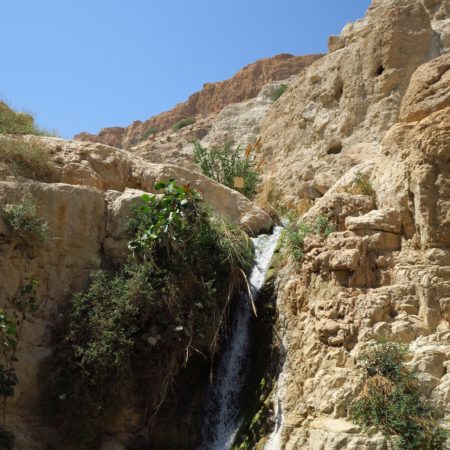Greetings from Israel!
As we mentioned in the first report, the region of Judah has five district climatological regions. We spent the first day in the Shephelah region, the next two days in the hill country, and today in the wilderness region east of Jerusalem. This region is very different – actually classified as a desert. However, instead of sand the land is an erodible limestone, resulting in very rugged terrain with steep valleys. The Wadi Qilt (valley) is a good example of this (see picture). This is the Qilt in which the story of the Good Samaritan takes place (Luke 10:25-37). Note the trail partway up the slope with a 4th century monastery. “Crossing over to the other side” as described in the story takes on a whole new meaning!
Our next stop was in Qumran, on the shores of the Dead Sea. You may know that this is the location where the Dead Sea Scrolls were discovered. As mentioned before, the limestone in this region is very erodible, resulting in many small caves. It was in these caves (12 to date) that scrolls and fragments were found. These scrolls contained entire Biblical books and portions of others. Astoundingly these texts, some from 1,000 years prior to the earliest known manuscripts, were nearly identical, therefore adding confidence in their accuracy.
Being a desert, the wilderness is very dry, and the largest nearby body of water is the Dead Sea, which does not support life due to its salinity and mineral content. Therefore water is a precious commodity. Imagine journeying through this wilderness and coming upon a spring gushing out of the desert, teeming with vegetation, ibexes, and hyrax. This is the scene that David would have seen as he hid from Saul in this exact valley. This story is told in 1 Samuel 24, and is well worth a read.
The Jordan River and the Dead Sea have long served as a boundary between nations. This was the case with the Roman Empire even at its height of power. The ever wary and suspicious Herod the Great (who also built the Herodium which we discussed yesterday) built a large fortress at the mount of Masada. This fortress was built on top of the Mount, which has vertical faces several hundred feet high. The fortress, which served as his summer home, is better known for the capture by rebel Jews in 66 AD and the later siege by the Romans in 73/74 AD. Instead of being captured and enslaved by the Romans, the more than 900 Jews killed each other in a mass murder/suicide. Masada has become a national treasure for Israel, symbolizing their freedom and determination to maintain their own nation. The massive siege ramp that the Romans built is still visible, and is the best remaining example of Roman siege practices.
We ended our day with a twilight swim (actually float) in the Dead Sea. Being 10 times more saline than the ocean, and therefore very dense, our bodies naturally floated on its surface with no effort. Truly a strange feeling – just don’t splash it in your eyes!
In Him,
Pastor Matheny and Matt Brand
View this post HERE to comment or discuss on our facebook page.

